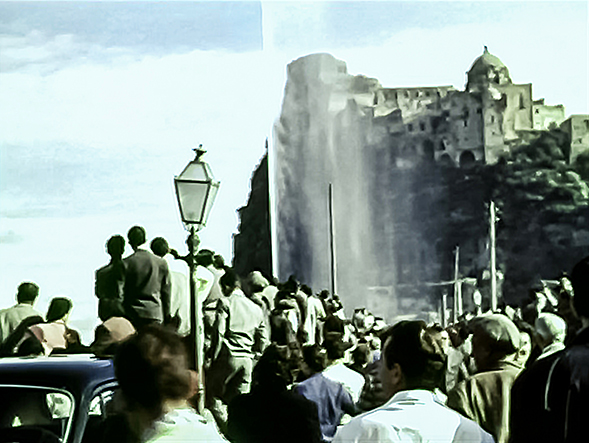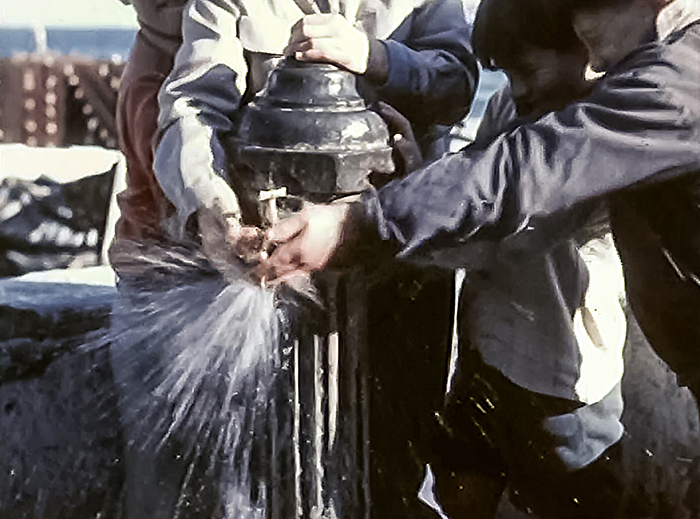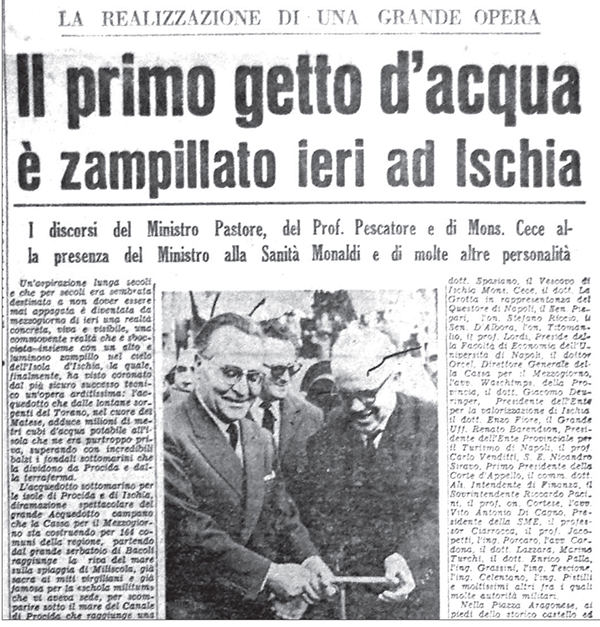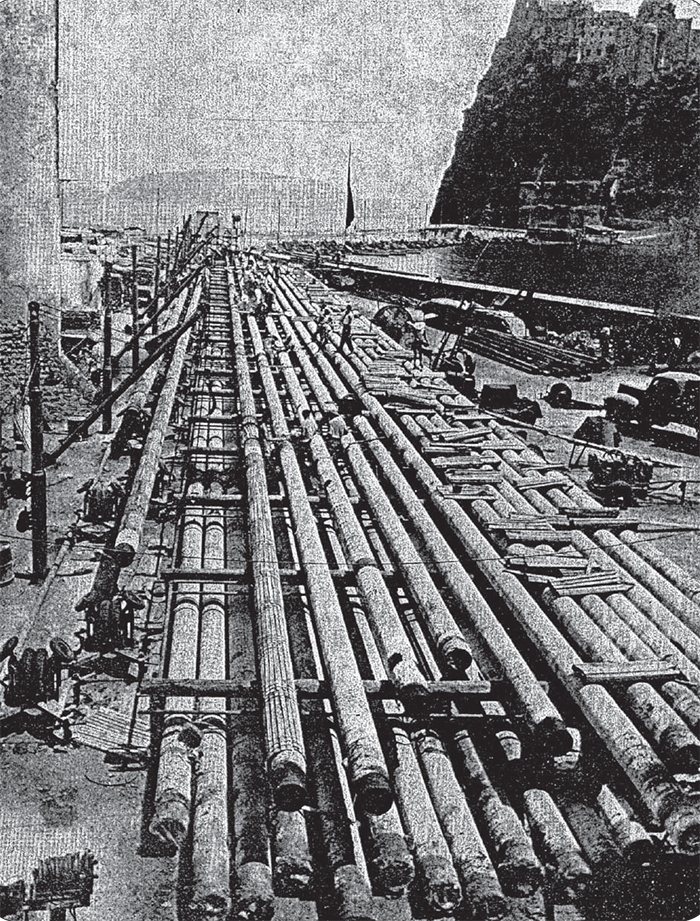Powerful, vigorous, lightning fast.


Forty meters high. Transparent against the blue sky of a clear autumn day. An intense applause greeted the gush of pure water, on that Sunday 9 November 1958, as it rose on the crowded square at the foot of the Aragonese Castle. And the sea all around was full of festively decorated boats, greeting with their sirens that novelty that could already be defined as historic. After years of waiting, the submarine aqueduct was finished and brought water to Ischia putting an end to its thirst. Procida had already benefited from it for a couple of years and now it was time for the island furthest from the mainland, the culmination of a project that begun to take shape at the beginning of a decade of great works and profound changes.
The uniqueness of that day was sealed by the large and unusual presence of guests who arrived from Naples and Rome for the inauguration.
Two ministers, national and regional politicians, representatives of institutions and the academic world together with the many technicians who followed the work in its complex evolution. A long list, reported in the chronicles of every newspaper of Monday, which did not fail to highlight the news. With the extensive report of the speech given by the Minister for the South Giulio Pastore. It was he, at twelve o'clock, who pressed the button that started the spectacular gush of water to spring into the Aragonese square, while the bells of every church on the island rang. And it was also he who inaugurated in the afternoon the fountains of Iechia Porto, Casamiceiola, Lacco Ameno and Forio, from which the water of Naples now flowed in every part of the island.
FROM THE SOURCES ON THE HILLS TO THE TANK SHIPS

Two and a half centuries earlier, in the hamlet at the foot of the Castle, the people of Ischia had celebrated the completion of the Buceto aqueduct with the same enthusiasm. And for a long time the spring of Barano managed to satisfy the needs of a significant part of the population, between Ischia and Barano. Just as the inhabitants of the other districts drew with specific aqueducts from the sources of cold and drinkable waters present, mostly, in the hilly areas of the interior: Ervaniello and Piesco in Casamicciola, Ciglio in the homonymous hamlet at the foot of the Epomeo, Piellero in Forio, Cava Sia in Panza, Cava dell'Acqua in Succhivo and Nitrodi, in Barano, the most lavish and appreciated for its healing properties, known since ancient times. And, close to the sea, the Mirtina water, in the Arso d’Ischia, and the Pisciariello water in Lacco Ameno, guilty of leaving black teeth on those who used it.
Fed by the rains, the reach of all these sources tended to change considerably over the course of the year, with inevitable consequences on the supply of the population. Which, therefore, also tried to make the most of rainwater, collecting it in the capacious cisterns that all the houses were equipped with. But water was still a limited availability good, so it should always be used sparingly. And the progressive demographic increase with the increased hygienic requirements made it more and more insufficient and precious. Until, in the last century, the sources that the island naturally had no longer existed and it was necessary to integrate their production more and more massively, resorting to imports from the mainland with tankers.
Large and small arrived every day, to supply the public reservoirs of every area of the island with drinkable water. And also the hotels rising along the Ischitan coast, with a further increase in water needs. Ships and barges anchored a few meters from the shore. With rowboats, the sailors carried the hoses ashore to the recipients' facilities. At the same time, there was a curious movement of boats in reverse. Anyone who had a watercraft, loaded it with demijohns and other useful containers and went to take supply from ship for the needs of the family. And it was not uncommon for someone to dump the water directly into the boat, even risking capsizing, as had sometimes happened to the hilarity of the onlookers.
A "STRANGE" IDEA TO QUENCH THE THIRST OF THE ISLANDS
 The water transport system was enough efficient already, but it did not guarantee its hygiene and potability. And, above all, it was already at the limit of its ability to meet the needs of an ever-growing community and a rapidly expanding tourism economy. Therefore in Ischia people began to think about possible solutions to the water problem, an absolute priority over any development program. And among the various hypotheses, supply from the mainland with a submarine pipeline was also considered. The idea was launched in the newspaper “Agire”(“taking action” in Italian) and aroused the interest of some administrators of the time, who had a general project drawn up. On the occasion of his vacation in Ischia in 1950, the honorable Attilio Piccioni was informed, who advised to present the project as soon as possible to the recently established Cassa per il Mezzogiorno. Done after his departure. And on March 16, 1951, the news of the green light for the work arrived in Ischia.
The water transport system was enough efficient already, but it did not guarantee its hygiene and potability. And, above all, it was already at the limit of its ability to meet the needs of an ever-growing community and a rapidly expanding tourism economy. Therefore in Ischia people began to think about possible solutions to the water problem, an absolute priority over any development program. And among the various hypotheses, supply from the mainland with a submarine pipeline was also considered. The idea was launched in the newspaper “Agire”(“taking action” in Italian) and aroused the interest of some administrators of the time, who had a general project drawn up. On the occasion of his vacation in Ischia in 1950, the honorable Attilio Piccioni was informed, who advised to present the project as soon as possible to the recently established Cassa per il Mezzogiorno. Done after his departure. And on March 16, 1951, the news of the green light for the work arrived in Ischia.
Just the day before, the Committee of Ministers for the South decided to build a submarine pipeline for Procida and Ischia. The work was included in the great project of the new Campania aqueduct, one of the most modern water systems in Europe. Defined since the beginning, without a shadow of hyperbole, colossal and futuristic. In fact, using water from springs in Campania and Molise, it had to serve Naples and 157 municipalities of the four Campania provinces with over 3 million inhabitants.
For its realization, thousands of skilled workers and technicians were mobilized day and night and an important industrial sector was created in the area.
SAME ROUTE AS THE TRAVELERS ON THE GRAND TOUR
 One rib of this colossus had to meet the needs of the Islands. The task was unprecedented for the length of the submarine sections, in which the laying of the two pipelines required highly innovative technical solutions and committed skilled labor from all over Italy. The huge branch that started from Naples quenched the thirst of the Phlegraean municipalities before starting its submarine journey from the beach of Miliscola, from where in ancient times the travelers of the Grand Tour headed for the islands. The sections of the new aqueduct were also identical to the stages of their journey to Ischia: immersed at a depth of eighteen meters along the entire Procida Canal, it re-emerged at Marina di Sancio Cattolico and from there continued to the reservoir for the island of Graziella, where the water had already arrived in 1956; then, the land stretch up to the part incorporated in the new bridge connecting Procida and Vivara; after crossing the islet, it returned to the sea until Ischia, where it returned to land at the historic Ponte Aragonese, to reach, a few meters away, the side of the square dominated by the Castle where the inaugural jet rose.
One rib of this colossus had to meet the needs of the Islands. The task was unprecedented for the length of the submarine sections, in which the laying of the two pipelines required highly innovative technical solutions and committed skilled labor from all over Italy. The huge branch that started from Naples quenched the thirst of the Phlegraean municipalities before starting its submarine journey from the beach of Miliscola, from where in ancient times the travelers of the Grand Tour headed for the islands. The sections of the new aqueduct were also identical to the stages of their journey to Ischia: immersed at a depth of eighteen meters along the entire Procida Canal, it re-emerged at Marina di Sancio Cattolico and from there continued to the reservoir for the island of Graziella, where the water had already arrived in 1956; then, the land stretch up to the part incorporated in the new bridge connecting Procida and Vivara; after crossing the islet, it returned to the sea until Ischia, where it returned to land at the historic Ponte Aragonese, to reach, a few meters away, the side of the square dominated by the Castle where the inaugural jet rose.
"Pure and appreciated water", the bishop of Ischia defined it in the inscription on the marble plaque displayed that serene November morning. In front of the spectacle of the sea and, in the background, the Matese mountains, guardians of the source of the Torano gifting that precious water. Even today, as seventy years ago, "for those who come here in the always sunny green Aenaria for their health".
Copyright video, foto e testi © 2020



Comments powered by CComment